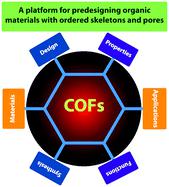当前位置:
X-MOL 学术
›
Chem. Soc. Rev.
›
论文详情
Our official English website, www.x-mol.net, welcomes your
feedback! (Note: you will need to create a separate account there.)
Covalent organic frameworks: an ideal platform for designing ordered materials and advanced applications
Chemical Society Reviews ( IF 40.4 ) Pub Date : 2020-12-7 , DOI: 10.1039/d0cs00620c Ruoyang Liu 1, 2, 3, 4, 5 , Ke Tian Tan 1, 2, 3, 4, 5 , Yifan Gong 1, 2, 3, 4, 5 , Yongzhi Chen 1, 2, 3, 4, 5 , Zhuoer Li 1, 2, 3, 4, 5 , Shuailei Xie 1, 2, 3, 4, 5 , Ting He 1, 2, 3, 4, 5 , Zhen Lu 1, 2, 3, 4, 5 , Hao Yang 1, 2, 3, 4, 5 , Donglin Jiang 1, 2, 3, 4, 5
Chemical Society Reviews ( IF 40.4 ) Pub Date : 2020-12-7 , DOI: 10.1039/d0cs00620c Ruoyang Liu 1, 2, 3, 4, 5 , Ke Tian Tan 1, 2, 3, 4, 5 , Yifan Gong 1, 2, 3, 4, 5 , Yongzhi Chen 1, 2, 3, 4, 5 , Zhuoer Li 1, 2, 3, 4, 5 , Shuailei Xie 1, 2, 3, 4, 5 , Ting He 1, 2, 3, 4, 5 , Zhen Lu 1, 2, 3, 4, 5 , Hao Yang 1, 2, 3, 4, 5 , Donglin Jiang 1, 2, 3, 4, 5
Affiliation

|
Covalent organic frameworks offer a molecular platform for integrating organic units into periodically ordered yet extended two- and three-dimensional polymers to create topologically well-defined polygonal lattices and built-in discrete micropores and/or mesopores. This polymer architecture is unique as it enables predesigning both primary- and high-order structures, greatly enhancing our capabilities of designing organic materials to produce predictable structures and to achieve unique properties and functions. Progress over the past 15 years in the design, synthesis and functional exploration of COFs has successively established the basis of the COF field and COFs have shown the great potential of chemistry in developing a class of amazing organic materials. In this review, we focus on analysing the historic developments of COFs to uncover a full materials and application picture by providing comprehensive yet clear guidance for molecular design, synthetic control and functional exploration. We scrutinise the structural components of COFs including building blocks, reactive sites and functional groups with the aim of finding the origins of structural designability and diversity, as well as multiple functionalities. We disclose strategies for designing and synthesising frameworks to construct various tailor-made interfaces, and for exploring skeletons and pores to design properties and functions. With well-defined skeletons, pores and interfaces that offer a chemical basis to trigger and control interactions with photons, excitons, phonons, polarons, electrons, holes, spins, ions and molecules, we illustrate the current status of our understandings of structure–property correlations, and unveil the principles for establishing a regime to design unique functions that originate from and are inherent to structures. We predict the key central issues in design and synthesis, the challenges in functional design and the future directions from the perspectives of chemistry, physics and materials science.
中文翻译:

共价有机框架:设计有序材料和高级应用程序的理想平台
共价有机骨架提供了一个分子平台,用于将有机单元整合到定期排列但扩展的二维和三维聚合物中,以创建拓扑明确定义的多边形晶格和内置的离散微孔和/或中孔。这种聚合物结构是独特的,因为它可以预先设计初级和高级结构,从而大大增强了我们设计有机材料的能力,以生产可预测的结构并实现独特的特性和功能。在过去15年中,COF的设计,合成和功能探索方面的进展已成功建立了COF领域的基础,并且COF在开发一类惊人的有机材料方面显示出巨大的化学潜力。在这篇评论中 我们通过为分子设计,合成控制和功能探索提供全面而清晰的指导,重点分析COF的历史发展,以揭示完整的材料和应用前景。我们仔细研究COF的结构组成部分,包括结构单元,反应位点和官能团,以寻找结构可设计性和多样性以及多种功能的起源。我们公开了用于设计和合成框架以构建各种量身定制的界面,以及探索骨架和孔以设计特性和功能的策略。具有明确定义的骨架,孔和界面,这些元素为触发和控制与光子,激子,声子,极化子,电子,空穴,自旋,离子和分子的相互作用提供了化学基础,我们举例说明了我们对结构-属性相关性的理解的当前状态,并揭示了建立制度的原则,以设计出源自结构或结构固有的独特功能。我们从化学,物理和材料科学的角度预测了设计和合成中的关键核心问题,功能设计中的挑战以及未来的方向。
更新日期:2020-12-09
中文翻译:

共价有机框架:设计有序材料和高级应用程序的理想平台
共价有机骨架提供了一个分子平台,用于将有机单元整合到定期排列但扩展的二维和三维聚合物中,以创建拓扑明确定义的多边形晶格和内置的离散微孔和/或中孔。这种聚合物结构是独特的,因为它可以预先设计初级和高级结构,从而大大增强了我们设计有机材料的能力,以生产可预测的结构并实现独特的特性和功能。在过去15年中,COF的设计,合成和功能探索方面的进展已成功建立了COF领域的基础,并且COF在开发一类惊人的有机材料方面显示出巨大的化学潜力。在这篇评论中 我们通过为分子设计,合成控制和功能探索提供全面而清晰的指导,重点分析COF的历史发展,以揭示完整的材料和应用前景。我们仔细研究COF的结构组成部分,包括结构单元,反应位点和官能团,以寻找结构可设计性和多样性以及多种功能的起源。我们公开了用于设计和合成框架以构建各种量身定制的界面,以及探索骨架和孔以设计特性和功能的策略。具有明确定义的骨架,孔和界面,这些元素为触发和控制与光子,激子,声子,极化子,电子,空穴,自旋,离子和分子的相互作用提供了化学基础,我们举例说明了我们对结构-属性相关性的理解的当前状态,并揭示了建立制度的原则,以设计出源自结构或结构固有的独特功能。我们从化学,物理和材料科学的角度预测了设计和合成中的关键核心问题,功能设计中的挑战以及未来的方向。















































 京公网安备 11010802027423号
京公网安备 11010802027423号